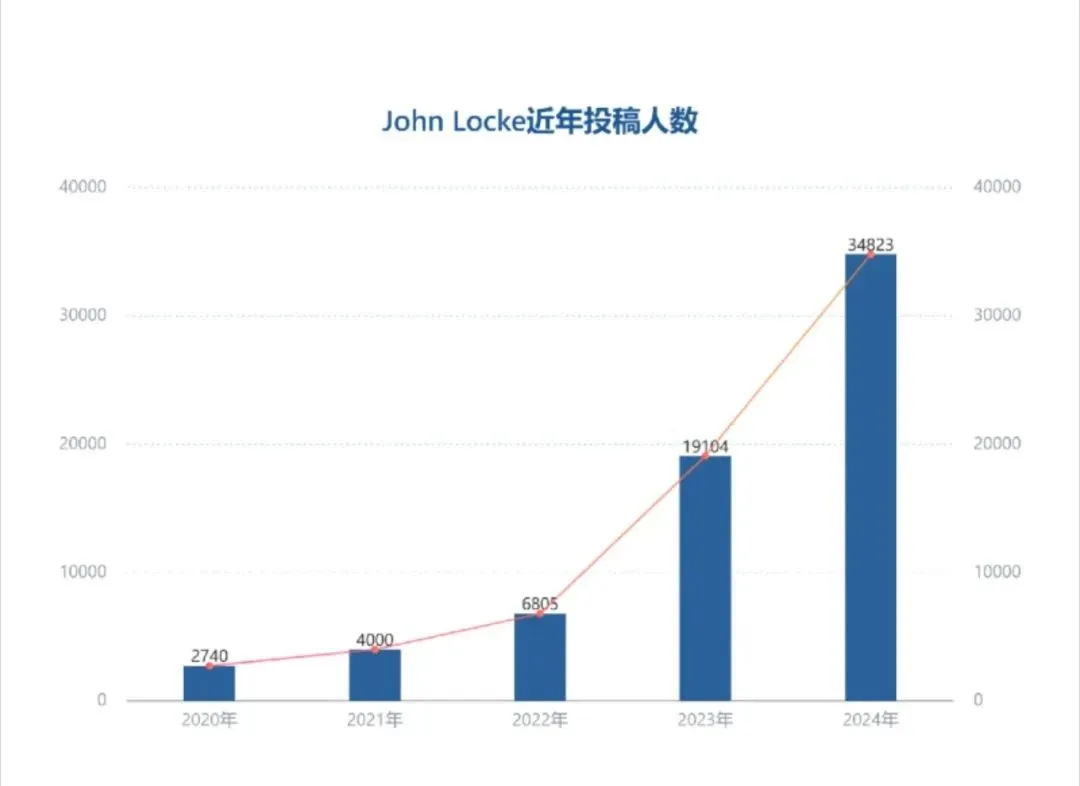随着John Locke写作竞赛的官方晚宴和颁奖晚会圆满落幕,2024赛季的获奖名单已经公布啦,今年全球共有34823名参赛选手,约有16.9%的参赛者入围,快来看看有没有你的名字吧!
Junior 赛区
Junior Category
Very High Commendations
Alexia Tan, Shanghai High School International Division
Courtney Fong, Rancho Pico Junior Highschool
Damhee Kim, North London Collegiate School Jeju
Elizabeth Xinyi Huo, Cheltenham Ladies CollegeFatima Merchant, St.Christopher's school
Juheon Kim, Fayston Preparatory of Suji
Lily Zhang, Pymble Ladies College
Luna Gao, Munich International School
Mia Pattinson, North London Collegiate School
Minlu Wang-He, Davidson Academy Online
Olha Kiriakova, Astra Nova
Tara Sproules-Nath, Pymble Ladies College
Yuran Wang, Millburn Middle School
3rd Prize
Ihsan Iftikar
The Greenwich Country Day School
2nd Prize
Doria Chen
Tanglin Trust School
1st Prize
Philip Taxiarchis
Westminster School
哲学赛区
Philosophy Category
Very High Commendations
Alida Chan, Tonbridge School
Benjamin Qin, Harrow International School Hong Kong
Elizabeth Zihan Chen, York House School
Serim Kwon, Seoul International School
Tom Gallear, Homeschooled
3rd Prize
Mihyeon Lee
North Raleigh Christian Academy
2nd Prize
Olivia Kang
Davidson Academy Onilne
1st Prize
Kan Zhang
BASIS International School Park Lane Harbour
政治学赛区
Politics Category
Very High Commendations
Ava Clarke-Stevens, James Allen Girls School
Chiara Ma, European School RheinMain
Chloe Liu, Lakeside School
Georgia Kemp, The Sandon School
Tony-JunLin Pan, Jericho High School
3rd Prize
Yijun Zhou
HD Shanghai School
2nd Prize
Marcell Pap
V. Kerületi Eötvös József Gimnázium
1st Prize
Xinen Han
The Experimental High School Attached to Beijing Normal University
经济学赛区
Economics Category
Very High Commendations
Alan Xuan Ming Gu, French International School
Anastasia Salikova, Colegio San José Estepona
Archie Carder, Queen Elizabeth Grammar School
HorncasteArjun Kshirsagar, Tonbridge School
Benjamin Dunn, Wolverhampton Grammar School
Carrie Zixuan Zhang, Crean Lutheran High
Dani Madanat, Rossall School
Hia Rivkin, The National Mathematics and Science College
Jingxing Bi, Cardiff Sixth Form College
Khushi Thapar, Sevenoaks School
Maksim Arbonen, Mill Hill School
Nandini Kumar, Oberoi International School, JVLR
Shubham Baheti, Sutton Grammar School
Yiqui Zhang, Shanghai Pinghe School
3rd Prize
Jiankai Zhao
Raffles Institution
2nd Prize
Audrey Kuk
St Hilda's School
1st Prize
Yuhao Liu
Guanghua Cambridge International School
历史赛区
History Category
Very High Commendations
Arabella Nawaz, Withington Girls School
Felix Lawson-Lyon, Hereford Cathedral School
Huanxi Zhou, Shanghai Starriver Bilingual School
Jessie Shen, Somerville HouseJunting Gan, Nanjing Foreign Language School
Mingda Liu, The Experimental High School
Affiliated to Beijing Normal University
Nicola Tan, St. Joseph's Institution International
Oriana Huang, Dwight Englewood School
Osman Mian, Oxford International College Brighton
Yuntian Zhao, Shanghai United International School, Wanyuan Campus
3rd Prize
Max Collison
Winchester College
2nd Prize
Zack Lam
Richard Montgomery High School
1st Prize
Maximus Sherwood
BHASVIC
法学赛区
Law Category
Very High Commendations
Aaron Brest, Singapore American School
Adrian Lee, Diocesan Boys' School
Alex Lau, Bromsgrove School
Alexander Dunderdale, City Of Bristol College
Emily Ball, Tonbridge Grammar School
lan Khai Ven Ng, Raffles Institution
3rd Prize
George Morrison
Eton College
2nd Prize
Maner Wen
Tianjin Yinghua Experimental School
1st Prize
Olivia Wei
Saint Cuthbert's College
神学赛区
Theology Category
Very High Commendations
Peter Clark, Battle Abbey School
3rd Prize
Caroline Tong
AP Homeschoolers Online Classes
2nd Prize
Ruoxiao Wang
Minhang Crosspoint Middle School
1st Prize
Alex Wang
Cranbrook Kingswood
心理学赛区
Psychology Category
Very High Commendations
Agatha Darragh, Colyton Grammar School
Alina Turaliyeva, Haileybury Almaty
Daisy Sun, West Point Grey Academy
Imogen Ciochon, St. Bartholomew's
Raelle Tiong, Northwood High School
Surabhi Marathe, The Orchid School
Vin Wiemelt, Homeschooled
3rd Prize
Sreyaa Sunjay
King Edwards VI Camp Hill School for Girls
2nd Prize
Johnny Yi
BASIS International School Park Lane Harbour
1st Prize
Jingyi Cheng
The High School Affiliated to Renmin University of China
Grand Prize
GRAND WINNER
Kan Zhang
BASIS International School Park Lane Harbour
2025赛季即将拉开序幕,想要提前备赛的同学可以领取我们的备赛资料包!
扫码免费领取John Locke 七大组别历年获奖论文合集+推荐书单+备赛规划⇓

John Locke 获奖论文集,获奖作品、赛题分析全覆盖!


John Locke备赛必读书单

John Locke写作大纲















